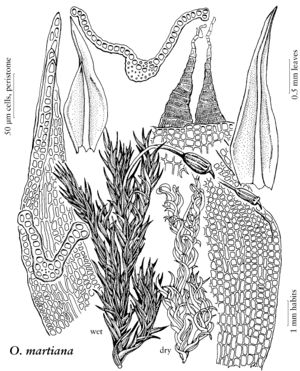Difference between revisions of "Oreas martiana"
Bryol. Univ. 1: 383. 1826,.
Basionym: Weissia martiana Hooker Musci Exot. 2: plate 104. 1819
FNA>Volume Importer |
imported>Volume Importer |
||
| (2 intermediate revisions by 2 users not shown) | |||
| Line 25: | Line 25: | ||
-->{{Treatment/Body | -->{{Treatment/Body | ||
|phenology=Capsules mature Jul–Aug. | |phenology=Capsules mature Jul–Aug. | ||
| − | |habitat=Alpine tundra, moderate to high elevations ( | + | |habitat=Alpine tundra, moderate to high elevations (ca. 0–4200 m) |
|distribution=Greenland;Alta.;B.C.;Alaska;Colo.;Europe;Asia. | |distribution=Greenland;Alta.;B.C.;Alaska;Colo.;Europe;Asia. | ||
|discussion=<p><i>Oreas martiana</i> is easily recognized by its golden color, the very thick and deep polsters with only a few millimeters of living leaves and much brown material below. In fruit it is unmistakable, with pendent, cygneous setae and strongly ribbed capsules. In the Front Range of Colorado it appears to be particularly abundant.</p> | |discussion=<p><i>Oreas martiana</i> is easily recognized by its golden color, the very thick and deep polsters with only a few millimeters of living leaves and much brown material below. In fruit it is unmistakable, with pendent, cygneous setae and strongly ribbed capsules. In the Front Range of Colorado it appears to be particularly abundant.</p> | ||
| Line 43: | Line 43: | ||
|family=Dicranaceae | |family=Dicranaceae | ||
|phenology=Capsules mature Jul–Aug. | |phenology=Capsules mature Jul–Aug. | ||
| − | |habitat=Alpine tundra, moderate to high elevations ( | + | |habitat=Alpine tundra, moderate to high elevations (ca. 0–4200 m) |
|distribution=Greenland;Alta.;B.C.;Alaska;Colo.;Europe;Asia. | |distribution=Greenland;Alta.;B.C.;Alaska;Colo.;Europe;Asia. | ||
|reference=None | |reference=None | ||
| Line 49: | Line 49: | ||
|publication year= | |publication year= | ||
|special status= | |special status= | ||
| − | |source xml=https:// | + | |source xml=https://bitbucket.org/aafc-mbb/fna-data-curation/src/2e0870ddd59836b60bcf96646a41e87ea5a5943a/coarse_grained_fna_xml/V27/V27_607.xml |
|genus=Oreas | |genus=Oreas | ||
|species=Oreas martiana | |species=Oreas martiana | ||
Latest revision as of 21:27, 5 November 2020
Stems 1.5–8.5 mm. Leaves 1.3–2 mm, distal laminal cells 6–10 µm. Perichaetial leaves 2–2.5 mm. Seta 3–7 mm. Capsule 0.6–0.9 mm; annulus of three rows of pale, thick-walled, quadrate cells; operculum 0.4–0.7 mm; peristome teeth 190–210 µm. Spores 16 µm.
Phenology: Capsules mature Jul–Aug.
Habitat: Alpine tundra, moderate to high elevations (ca. 0–4200 m)
Distribution
Greenland, Alta., B.C., Alaska, Colo., Europe, Asia.
Discussion
Oreas martiana is easily recognized by its golden color, the very thick and deep polsters with only a few millimeters of living leaves and much brown material below. In fruit it is unmistakable, with pendent, cygneous setae and strongly ribbed capsules. In the Front Range of Colorado it appears to be particularly abundant.
Selected References
None.
Lower Taxa
None.
